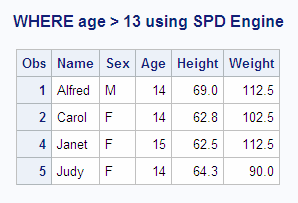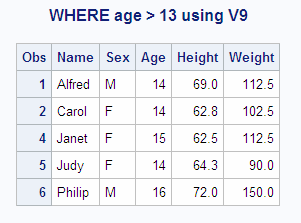ENDOBS= Data Set Option
Specifies the end observation number in a user-defined range of observations to be processed.
| Valid in: | DATA step and PROC step |
| Default: | The last observation in the data set |
| Restrictions: | Use ENDOBS= with input data sets only |
| Cannot be used with the OBS= system or data set option or the FIRSTOBS= system and data set option | |
| Interactions: | ENDOBS= LIBNAME Statement Option |
| STARTOBS= LIBNAME Statement Option | |
| STARTOBS= Data Set Option | |
| Engine: | SPD Engine only |
Details
Specifying a Range of Observations
By default, the SPD Engine processes all of the observations in the entire data set unless you specify a range
of observations with the STARTOBS= or ENDOBS= options. If the STARTOBS= option is
used without the ENDOBS= option, the implied value of ENDOBS= is the end of the data
set. When both options are used together, the value of ENDOBS= must be greater than
the value of STARTOBS=.
The ENDOBS= data set option in the SPD Engine works the same way as the OBS= data
set option in the default Base SAS engine. The
only difference is when ENDOBS= is specified in a WHERE expression.
Using ENDOBS= with a WHERE Expression
When ENDOBS= is used in a WHERE expression, the ENDOBS= value represents the last
observation to process, rather than the number
of observations to return. The following examples show the difference.
Note: The OBS= system option and
the OBS= data set option cannot be used with STARTOBS= or ENDOBS=
data set or LIBNAME options.
Comparisons
The ENDOBS= data set
option overrides the ENDOBS= LIBNAME statement option.
Examples
Example 1: Using the ENDOBS= Data Set Option
A data set is created and processed by the SPD Engine with ENDOBS=5 option specified.
The WHERE expression is applied to the data set ending with observation number 5.
The PRINT procedure
prints four observations, which are the observations qualified by the WHERE expression.
libname growth spde 'SAS-library';
data growth.teens;
input Name $ Sex $ Age Height Weight;
list;
datalines;
Alfred M 14 69.0 112.5
Carol F 14 62.8 102.5
James M 13 57.3 83.0
Janet F 15 62.5 112.5
Judy F 14 64.3 90.0
Philip M 16 72.0 150.0
Zeke M 14 71.1 105.0
Alice F 14 65.1 91.0
William M 15 66.5 112.0
;
proc print data=growth.teens (endobs=5);
where age >13;
title 'WHERE age > 13 using SPD Engine';
run;ENDOBS=

Example 2: OBS= with SPD Engine
The same data set is processed with OBS=5 specified. PROC PRINT prints five observations,
which are all of the observations qualified by the WHERE expression, ending with the
fifth qualified observation.
libname growth spde 'SAS-library';
data growth.teens;
input Name $ Sex $ Age Height Weight;
list;
datalines;
Alfred M 14 69.0 112.5
Carol F 14 62.8 102.5
James M 13 57.3 83.0
Janet F 15 62.5 112.5
Judy F 14 64.3 90.0
Philip M 16 72.0 150.0
Zeke M 14 71.1 105.1
Alice F 14 65.1 91.0
William M 15 66.5 112.0
;
proc print data=growth.teens (obs=5);
where age >13;
title 'WHERE age > 13 using V9';
run;OBS=

Copyright © SAS Institute Inc. All Rights Reserved.